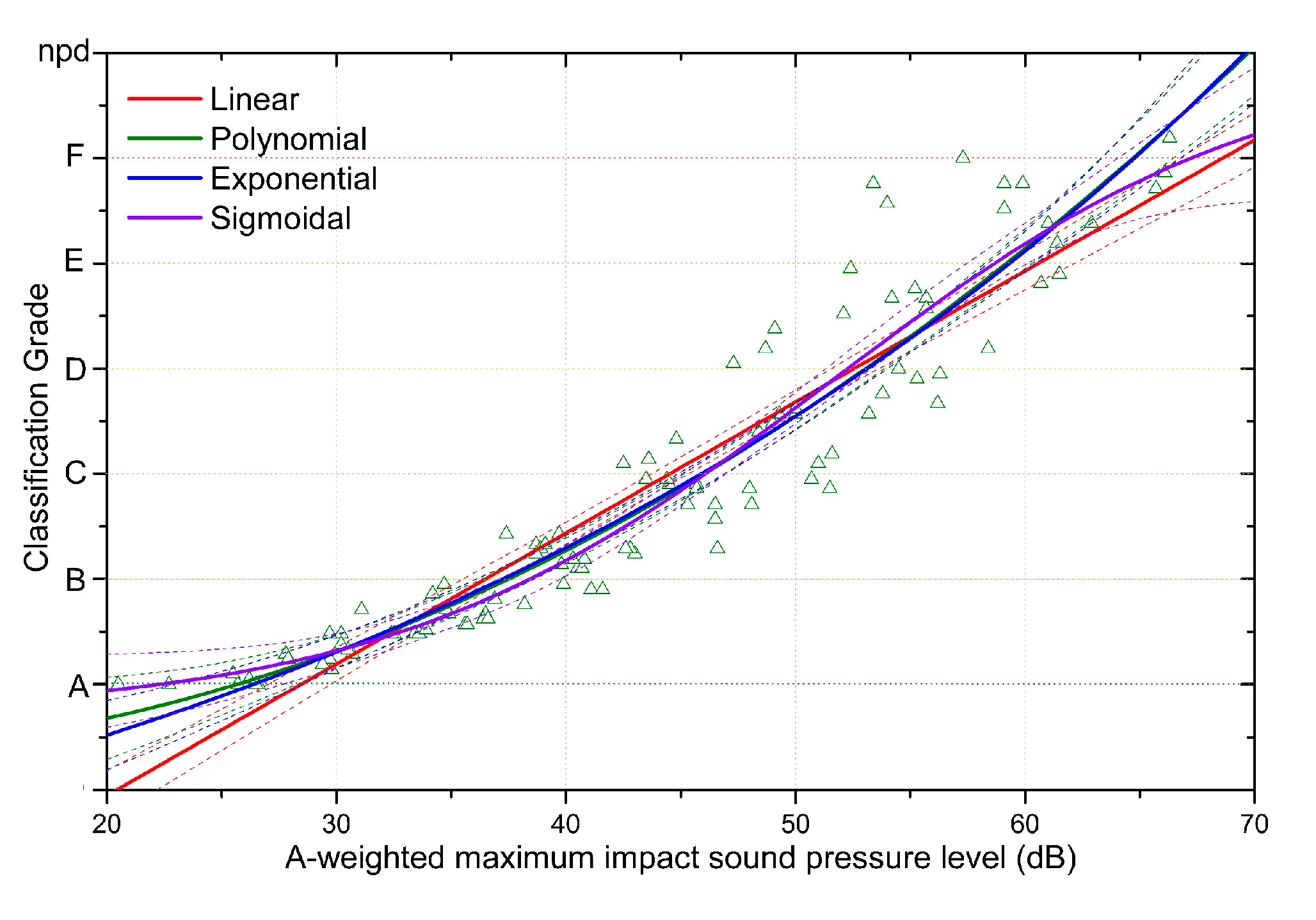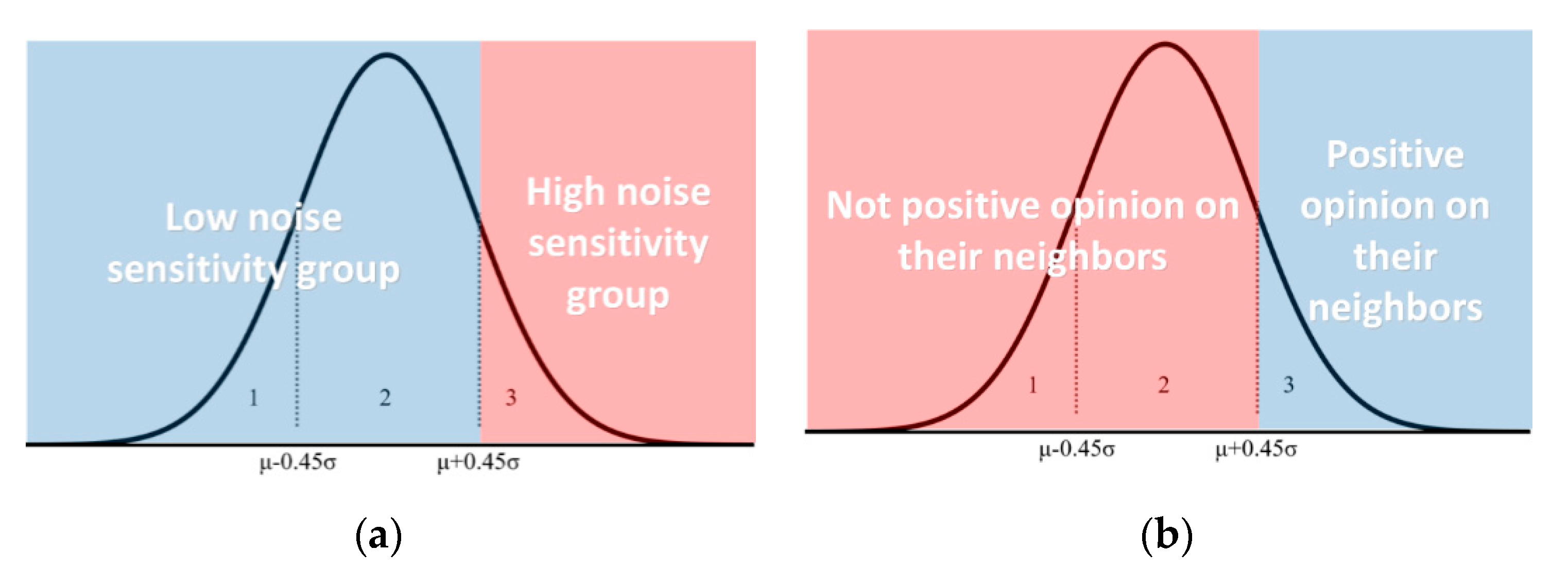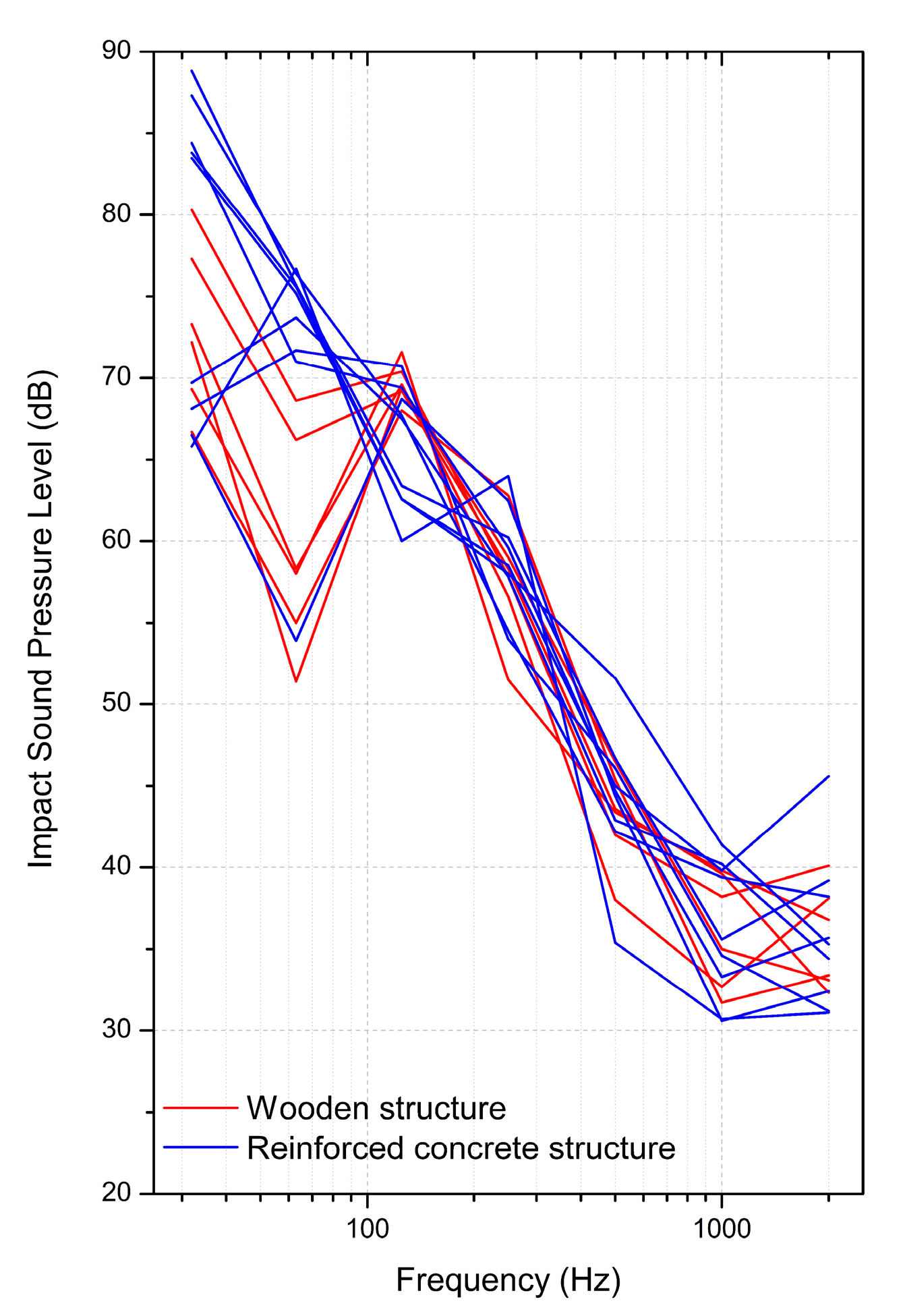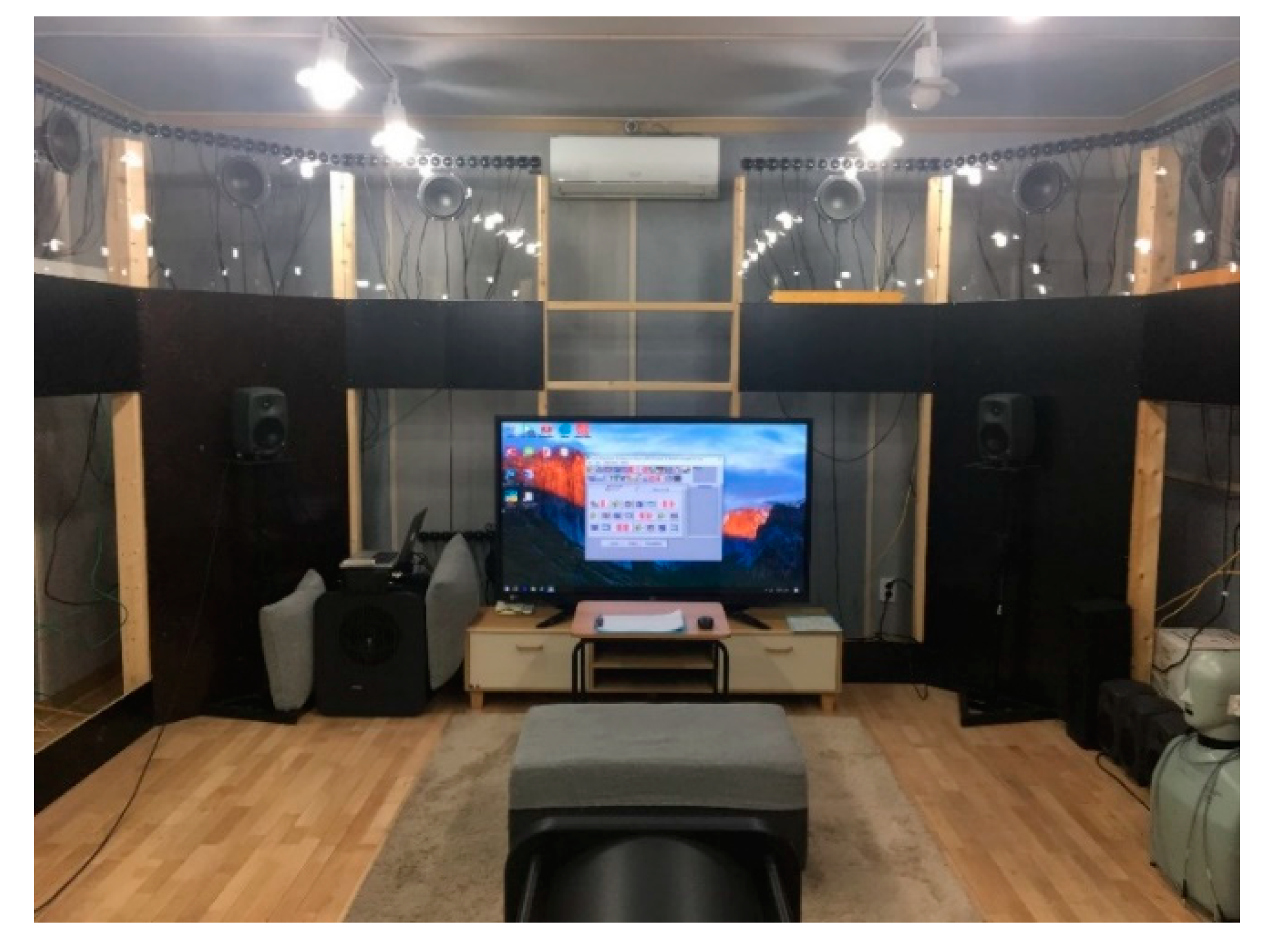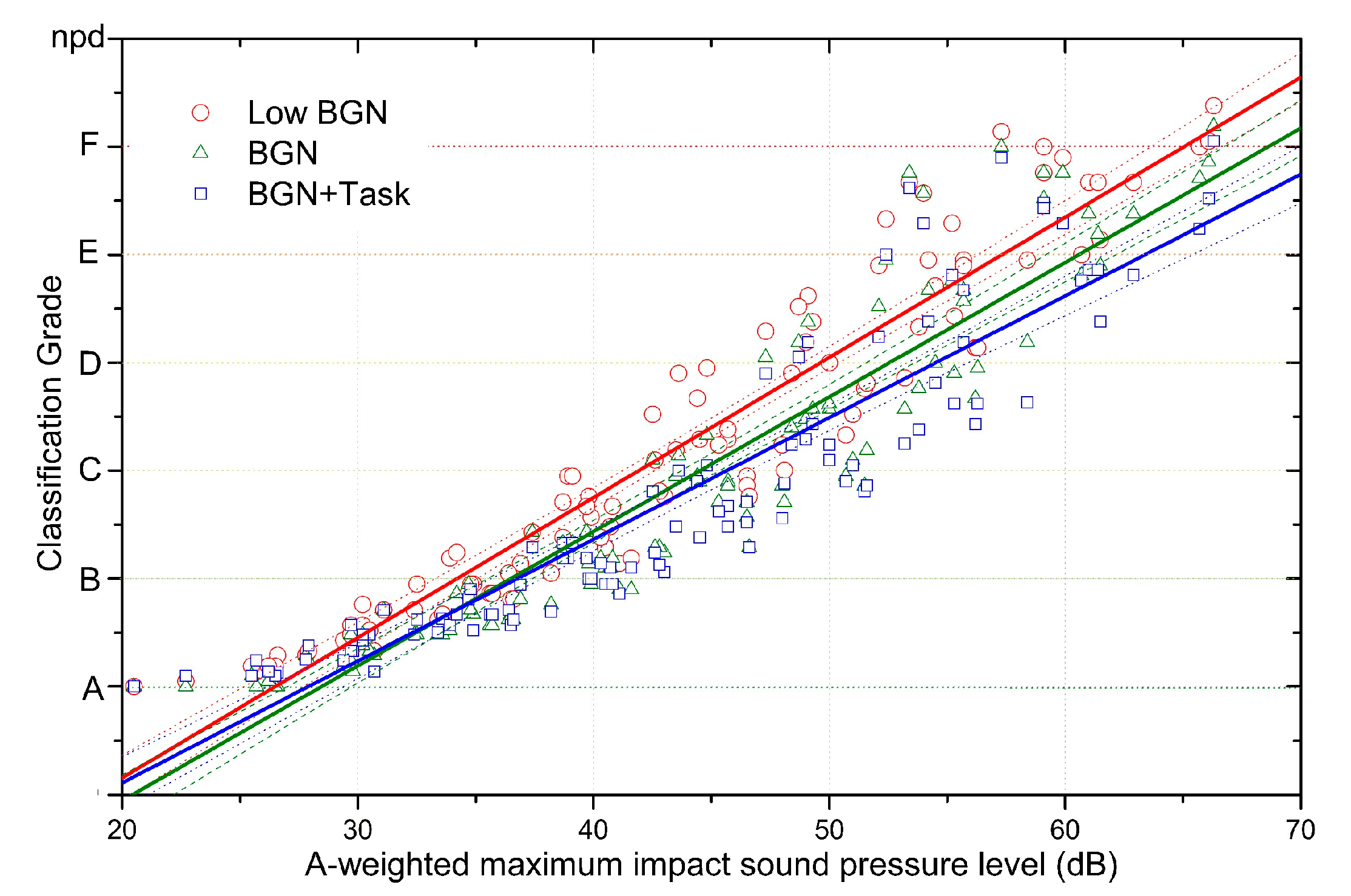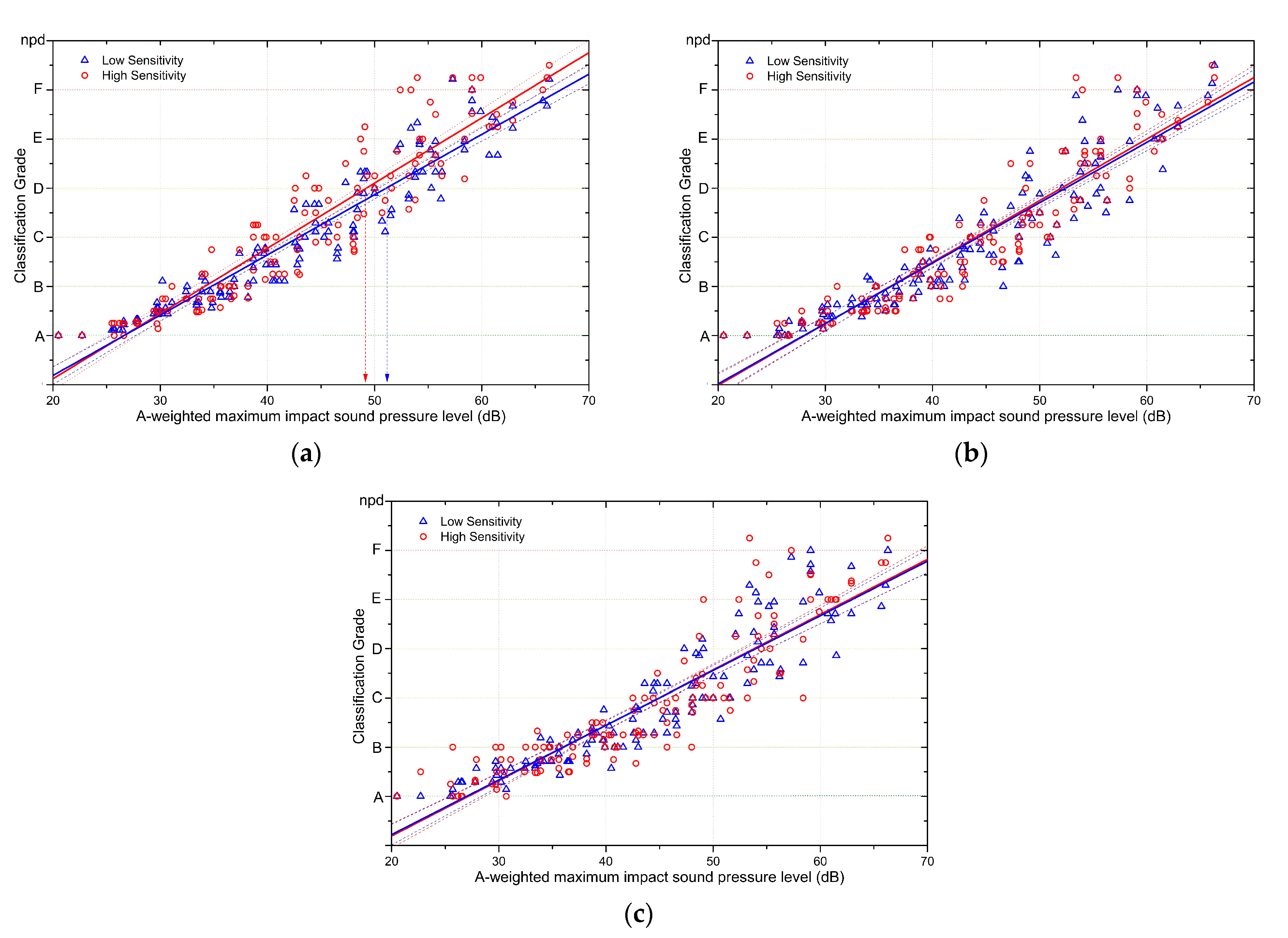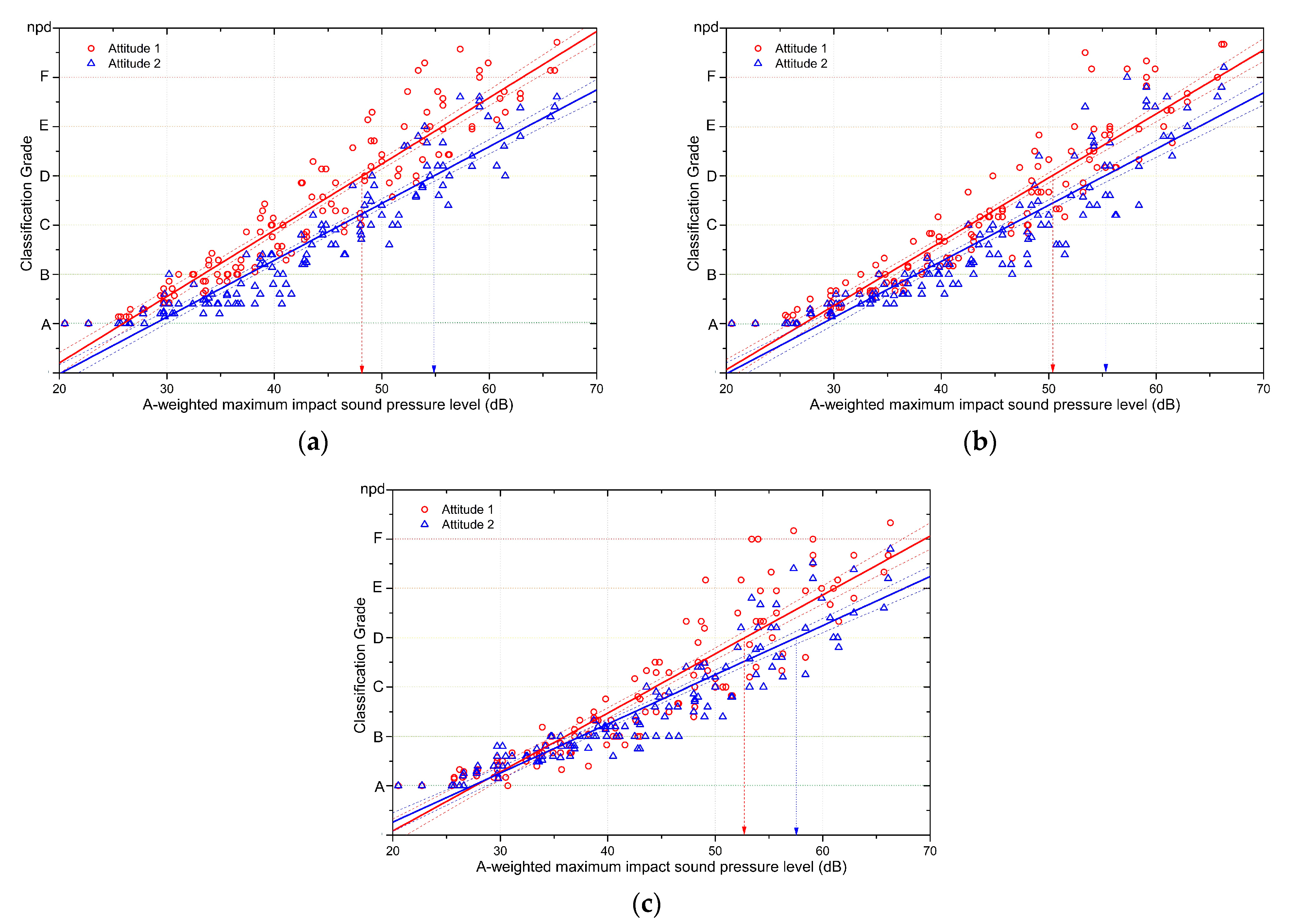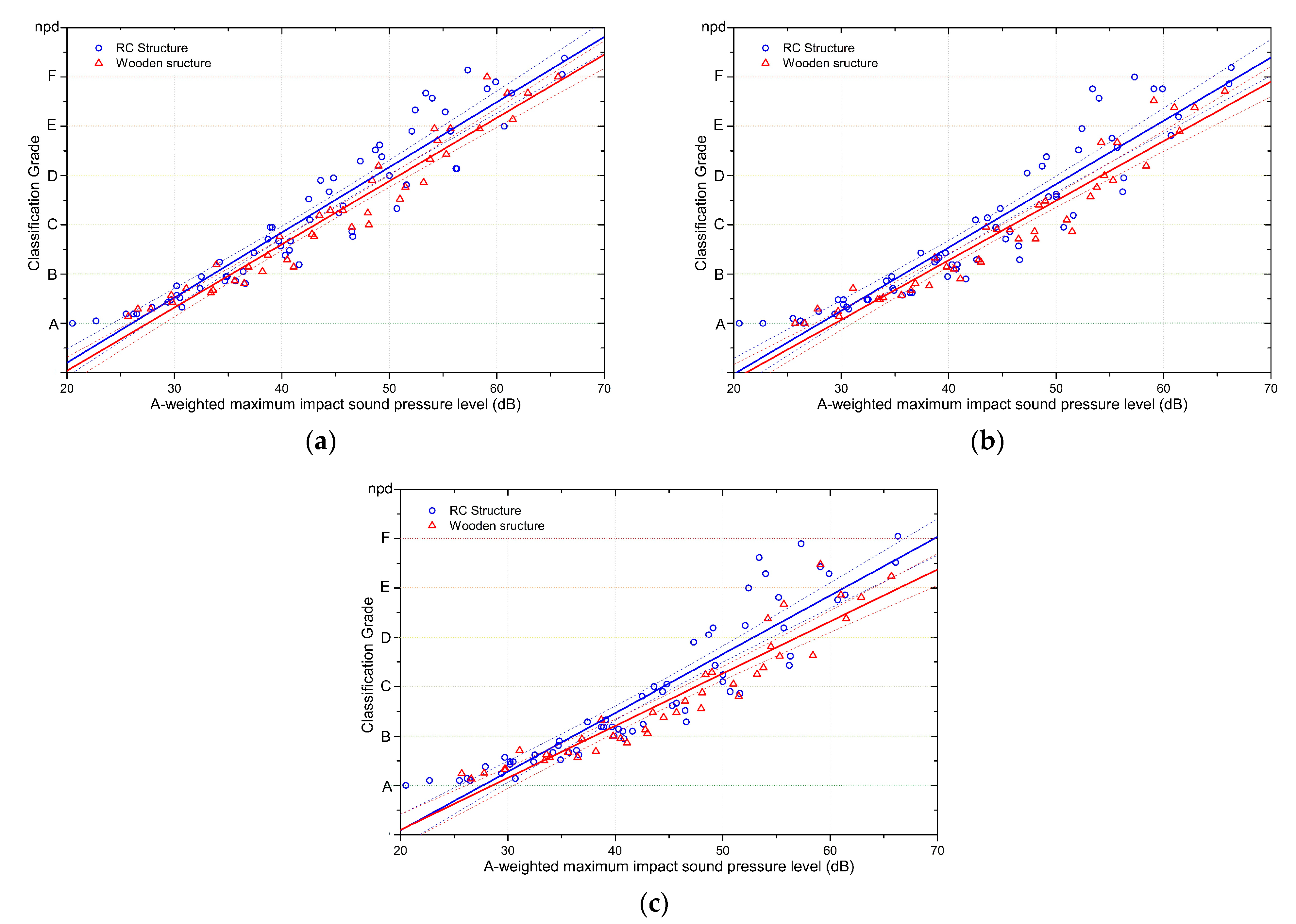Figure 1.
Two subject groups divided based on the questionnaire survey results on noise sensitivity and attitude toward the neighbours. (a) Noise sensitivity. (b) Attitude toward their neighbours.
Figure 1.
Two subject groups divided based on the questionnaire survey results on noise sensitivity and attitude toward the neighbours. (a) Noise sensitivity. (b) Attitude toward their neighbours.
Figure 2.
Frequency characteristics of the 15 rubber ball impact sounds used in the subjective experiment.
Figure 2.
Frequency characteristics of the 15 rubber ball impact sounds used in the subjective experiment.
Figure 3.
Listening chamber where the subjective experiment was conducted.
Figure 3.
Listening chamber where the subjective experiment was conducted.
Figure 4.
Changes in the subjective responses with varying impact sound pressure levels in the presence or absence of background noise and with the addition of an internet browsing task. Dashed and dotted lines show the 95% confidence levels of the regression line.
Figure 4.
Changes in the subjective responses with varying impact sound pressure levels in the presence or absence of background noise and with the addition of an internet browsing task. Dashed and dotted lines show the 95% confidence levels of the regression line.
Figure 5.
Comparison of the responses to rubber ball impact sounds between the sensitivity groups. Dashed lines show the 95% confidence levels of the regression line. (a) Impact sound responses of the two sensitivity groups in the low background noise condition. (b) Impact sound responses of the two sensitivity groups in the presence of background noise. (c) Impact sound responses of the two sensitivity groups when performing an internet browsing task in the presence of background noise.
Figure 5.
Comparison of the responses to rubber ball impact sounds between the sensitivity groups. Dashed lines show the 95% confidence levels of the regression line. (a) Impact sound responses of the two sensitivity groups in the low background noise condition. (b) Impact sound responses of the two sensitivity groups in the presence of background noise. (c) Impact sound responses of the two sensitivity groups when performing an internet browsing task in the presence of background noise.
Figure 6.
Comparison of the responses to rubber ball impact sounds between the attitude groups. Dashed lines show the 95% confidence level of the regression line. (a) Impact sound responses of the two attitude groups in the low background noise condition. (b) Impact sound responses of the two attitude groups in the presence of background noise. (c) Impact sound responses of the two attitude groups when performing an internet browsing task in the presence of background noise.
Figure 6.
Comparison of the responses to rubber ball impact sounds between the attitude groups. Dashed lines show the 95% confidence level of the regression line. (a) Impact sound responses of the two attitude groups in the low background noise condition. (b) Impact sound responses of the two attitude groups in the presence of background noise. (c) Impact sound responses of the two attitude groups when performing an internet browsing task in the presence of background noise.
Figure 7.
Comparison of responses to rubber ball impact sounds between the structure types. Dashed lines show the 95% confidence levels of the regression line. (a) Impact sound responses for the two structure types in the low background noise condition. (b) Impact sound responses for the two structure types in the presence of background noise. (c) Impact sound responses for the two structure types when performing an internet browsing task in the presence of background noise.
Figure 7.
Comparison of responses to rubber ball impact sounds between the structure types. Dashed lines show the 95% confidence levels of the regression line. (a) Impact sound responses for the two structure types in the low background noise condition. (b) Impact sound responses for the two structure types in the presence of background noise. (c) Impact sound responses for the two structure types when performing an internet browsing task in the presence of background noise.
Table 1.
Description terms of the quality of the different classes in ISO/TS 19488.
Table 1.
Description terms of the quality of the different classes in ISO/TS 19488.
| Class | General |
|---|
| A | A quiet atmosphere with a high level of protection against sound. This class may be applied where a considerably better climate is asked for. |
| B | Under normal circumstances a good protection against sound without too much restriction to the behaviour of the occupants. This class may be applied where a better acoustic climate is asked for. |
| C | Protection against considerable distribution under normal behaviour of the occupants, bearing in mind their neighbours. Newer building construction in many countries are likely to fulfil or exceed this class. |
| D | Disturbance by noise may be expected more than occasionally, even in case of comparable behaviour of occupants, adjusted to neighbours. Newer building construction in most countries are likely to fulfil or exceed this class. |
| E | A low protection is offered against intruding sounds. To be applied mainly for classification of existing housing (before renovation). |
| F | A very low protection is offered against intruding sounds. To be applied only for classification of older, existing housing (before renovation) |
| npd | No performance determined |
Table 2.
The experimental conditions.
Table 2.
The experimental conditions.
| Experiment | Background Noise | Internet Surfing |
|---|
| 1st | 20 dB(A) | - |
| 2nd | Pink noise 37 dB(A) | - |
| 3rd | Pink noise 37 dB(A) | Text based contents |
Table 3.
Linear regression analysis results for the subjective responses during the 3 experimental conditions.
Table 3.
Linear regression analysis results for the subjective responses during the 3 experimental conditions.
| Experiment | Intercept | Slope | R-Square |
|---|
| 1st Low-BGN | −2.43833 | 0.12974 | 0.90992 |
| 2nd With BGN | −2.54295 | 0.1245 | 0.87815 |
| 3rd With BGN + Task | −2.14434 | 0.1127 | 0.84868 |
Table 4.
Classification grades calculated based on the subjective experiment results (Li,AFmax, (dB)).
Table 4.
Classification grades calculated based on the subjective experiment results (Li,AFmax, (dB)).
| Experiment. | A | B | C | D | E | F |
|---|
| 1st Low BGN | 26.5 | 34.2 | 41.9 | 49.6 | 57.3 | 65.0 |
| 2nd With BGN | 28.5 | 36.5 | 44.5 | 52.6 | 60.6 | 68.6 |
| 3rd With BGN + Task | 27.9 | 36.8 | 45.6 | 54.5 | 63.4 | 72.3 |
Table 5.
Results of the linear regression analysis for subjective responses in each of the 3 experimental conditions for the groups divided by noise sensitivity.
Table 5.
Results of the linear regression analysis for subjective responses in each of the 3 experimental conditions for the groups divided by noise sensitivity.
| Experiment | Noise Sensitivity | Intercept | Slope | R-Square |
|---|
| 1st Low-BGN | High | −2.53086 | 0.13267 | 0.86544 |
| Low | −2.26499 | 0.122264 | 0.90348 |
| 2nd With BGN | High | −2.51513 | 0.12525 | 0.86365 |
| Low | −2.43993 | 0.12288 | 0.85882 |
| 3rd With BGN + Task | High | −2.05441 | 0.11247 | 0.80495 |
| Low | −2.00145 | 0.11117 | 0.84869 |
Table 6.
Rubber ball impact sound classification grades calculated based on the results of the 3 subjective experiments for the groups divided by noise sensitivity (Li,AFmax, (dB)).
Table 6.
Rubber ball impact sound classification grades calculated based on the results of the 3 subjective experiments for the groups divided by noise sensitivity (Li,AFmax, (dB)).
| Experiment | Noise Sensitivity | A | B | C | D | E | F |
|---|
| 1st Low-BGN | High | 26.6 | 34.2 | 41.7 | 49.2 | 56.8 | 64.3 |
| Low | 26.7 | 34.9 | 43.1 | 51.2 | 59.4 | 67.6 |
| 2nd With BGN | High | 28.1 | 36.0 | 44.0 | 52.0 | 60.0 | 68.0 |
| Low | 28.0 | 36.1 | 44.3 | 52.4 | 60.5 | 68.7 |
| 3rd With BGN + Task | High | 27.2 | 36.0 | 44.9 | 53.8 | 62.7 | 71.6 |
| Low | 27.0 | 36.0 | 45.0 | 54.0 | 63.0 | 72.0 |
Table 7.
Differences between the classification grade values for the sensitivity groups in the 3 experimental conditions.
Table 7.
Differences between the classification grade values for the sensitivity groups in the 3 experimental conditions.
| Difference of Classification Grade Value between Two Sensitivity Groups (Li,A,Fmax (dB)) | A | B | C | D | E | F |
|---|
| 1st Low BGN | 0.1 | 0.7 | 1.4 | 2.0 | 2.6 | 3.3 |
| 2nd With BGN | −0.1 | 0.1 | 0.2 | 0.4 | 0.5 | 0.7 |
| 3rd With BGN + Task | −0.2 | 0.0 | 0.1 | 0.2 | 0.3 | 0.4 |
Table 8.
Effects of background noise and additional tasks on the classification grade values for the sensitivity groups.
Table 8.
Effects of background noise and additional tasks on the classification grade values for the sensitivity groups.
| Difference of Classification Grade Value between Two Sensitivity Groups (Li,A,Fmax (dB)) | A | B | C | D | E | F |
|---|
| High sensitivity group | BGN effect | 1.5 | 1.8 | 2.3 | 2.8 | 3.2 | 3.7 |
| Task effect | −0.9 | 0.0 | 0.9 | 1.8 | 2.7 | 3.6 |
| Low sensitivity group | BGN effect | 1.3 | 1.2 | 1.2 | 1.2 | 1.1 | 1.1 |
| Task effect | −0.1 | 0.1 | 0.2 | 0.4 | 0.5 | 0.7 |
Table 9.
Results of the linear regression analysis for subjective responses in each of the 3 experimental conditions for groups divided by attitudes towards their neighbours.
Table 9.
Results of the linear regression analysis for subjective responses in each of the 3 experimental conditions for groups divided by attitudes towards their neighbours.
| Experiment | Attitude on Neighbours | Intercept | Slope | R-Square |
|---|
| 1st Low-BGN | Not positive | −2.48525 | 0.13451 | 0.89086 |
| Positive | −2.32545 | 0.1153 | 0.8796 |
| 2nd With BGN | Not positive | −2.52999 | 0.12979 | 0.88484 |
| Positive | −2.29506 | 0.114 | 0.83974 |
| 3rd With BGN + Task | Not positive | −2.30621 | 0.11954 | 0.82902 |
| Positive | −1.72772 | 0.09953 | 0.8471 |
Table 10.
Rubber ball impact sound classification grades calculated based on the results of the 3 subjective experiments for the groups divided by attitudes towards their neighbours (Li,AFmax, (dB)).
Table 10.
Rubber ball impact sound classification grades calculated based on the results of the 3 subjective experiments for the groups divided by attitudes towards their neighbours (Li,AFmax, (dB)).
| Experiment | Attitude on
Neighbours | A | B | C | D | E | F |
|---|
| 1st Low-BGN | Not positive | 25.9 | 33.3 | 40.8 | 48.2 | 55.6 | 63.1 |
| Positive | 28.8 | 37.5 | 46.2 | 54.9 | 63.5 | 72.2 |
| 2nd With BGN | Not positive | 27.2 | 34.9 | 42.6 | 50.3 | 58.0 | 65.7 |
| Positive | 28.9 | 37.7 | 46.4 | 55.2 | 64.0 | 72.8 |
| 3rd With BGN + Task | Not positive | 27.7 | 36.0 | 44.4 | 52.8 | 61.1 | 69.5 |
| Positive | 27.4 | 37.5 | 47.5 | 57.5 | 67.6 | 77.6 |
Table 11.
Differences between the classification grade values for the attitude groups in the 3 experimental conditions.
Table 11.
Differences between the classification grade values for the attitude groups in the 3 experimental conditions.
| Difference of Classification Grade Value between Two Attitude Groups (Li,A,Fmax (dB)) | A | B | C | D | E | F |
|---|
| 1st Low BGN | 2.9 | 4.2 | 5.4 | 6.7 | 7.9 | 9.1 |
| 2nd With BGN | 1.7 | 2.8 | 3.8 | 4.9 | 6.0 | 7.1 |
| 3rd With BGN + Task | −0.3 | 1.5 | 3.1 | 4.7 | 6.5 | 8.1 |
Table 12.
Effects of background noise and additional tasks on the classification grade values for the attitude groups.
Table 12.
Effects of background noise and additional tasks on the classification grade values for the attitude groups.
| Difference of Classification Grade Value between Two Attitude Groups (Li,A,Fmax (dB)) | A | B | C | D | E | F |
|---|
| Not positive attitude group | BGN effect | 1.3 | 1.6 | 1.8 | 2.1 | 2.4 | 2.6 |
| Task effect | 0.5 | 1.1 | 1.8 | 2.5 | 3.1 | 3.8 |
| Positive attitude group | BGN effect | 0.1 | 0.2 | 0.2 | 0.3 | 0.5 | 0.6 |
| Task effect | −1.5 | −0.2 | 1.1 | 2.3 | 3.6 | 4.8 |
Table 13.
Results of the linear regression analysis for subjective responses in each of the 3 experimental conditions for the different structure types.
Table 13.
Results of the linear regression analysis for subjective responses in each of the 3 experimental conditions for the different structure types.
| Experiment | Structure | Intercept | Slope | R-Square |
|---|
| 1st Low-BGN | RC | −2.44235 | 0.13219 | 0.90275 |
| wooden | −2.25766 | 0.12827 | 0.94125 |
| 2nd With BGN | RC | −2.60029 | 0.12849 | 0.86908 |
| wooden | −2.55427 | 0.12086 | 0.92307 |
| 3rd With BGN + Task | RC | −2.29009 | 0.11897 | 0.85047 |
| wooden | −2.01516 | 0.1056 | 0.89072 |
Table 14.
Rubber ball impact sound classification grades calculated based on the results of the 3 subjective experiments for the different structure types (Li,AFmax, (dB)).
Table 14.
Rubber ball impact sound classification grades calculated based on the results of the 3 subjective experiments for the different structure types (Li,AFmax, (dB)).
| Experiment | Structure | A | B | C | D | E | F |
|---|
| 1st Low-BGN | RC | 26.0 | 33.6 | 41.2 | 48.7 | 56.3 | 63.9 |
| wooden | 27.5 | 35.3 | 43.1 | 50.9 | 58.7 | 66.5 |
| 2nd With BGN | RC | 28.0 | 35.8 | 43.6 | 51.4 | 59.2 | 66.9 |
| wooden | 29.4 | 37.7 | 46.0 | 54.2 | 62.5 | 70.8 |
| 3rd With BGN + Task | RC | 27.7 | 36.1 | 44.5 | 52.9 | 61.3 | 69.7 |
| wooden | 28.6 | 38.0 | 47.5 | 57.0 | 66.4 | 75.9 |
Table 15.
Differences between the classification grade values for different structure types in the 3 experimental conditions.
Table 15.
Differences between the classification grade values for different structure types in the 3 experimental conditions.
| Difference of Classification Grade Value between Two Structures (Li,A,Fmax (dB)) | A | B | C | D | E | F |
|---|
| 1st Low BGN | −1.5 | −1.7 | −1.9 | −2.2 | −2.4 | −2.6 |
| 2nd With BGN | −1.4 | −1.9 | −2.4 | −2.8 | −3.3 | −3.9 |
| 3rd With BGN + Task | −0.9 | −1.9 | −3.0 | −4.1 | −5.1 | −6.2 |
Table 16.
Effects of background noise and additional tasks on the classification grade values for the different structure types.
Table 16.
Effects of background noise and additional tasks on the classification grade values for the different structure types.
| Difference of Classification Grade Value between Two Structures (Li,A,Fmax (dB)) | A | B | C | D | E | F |
|---|
| RC | BGN effect | 2.0 | 2.2 | 2.4 | 2.7 | 2.9 | 3.0 |
| Task effect | −0.3 | 0.3 | 0.9 | 1.5 | 2.1 | 2.8 |
| Wooden | BGN effect | 1.9 | 2.4 | 2.9 | 3.3 | 3.8 | 4.3 |
| Task effect | −0.8 | 0.3 | 1.5 | 2.8 | 3.9 | 5.1 |
